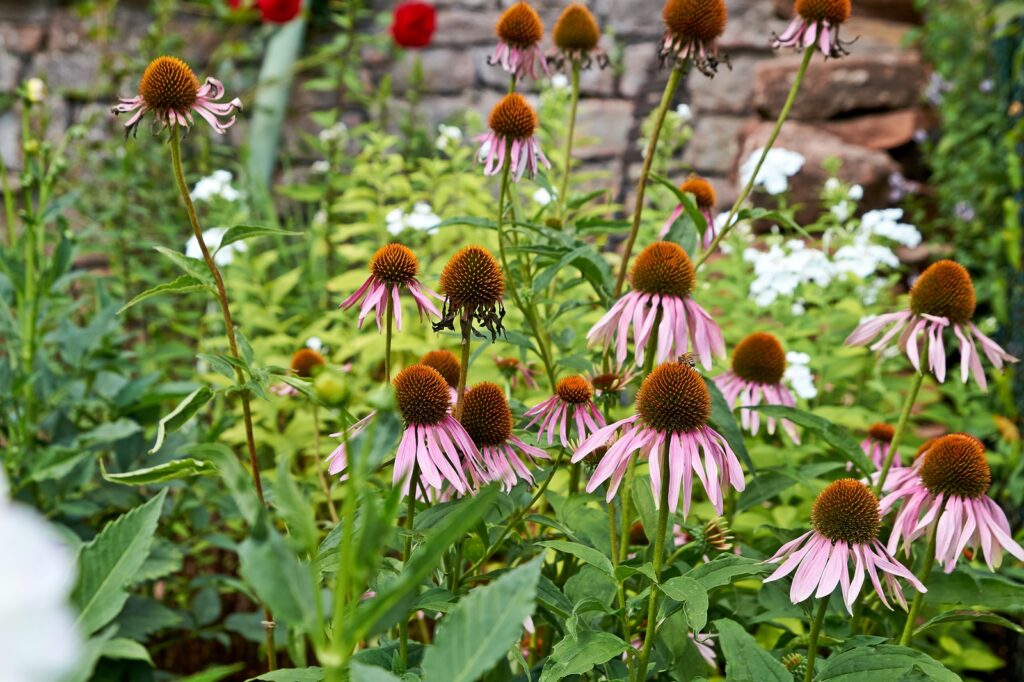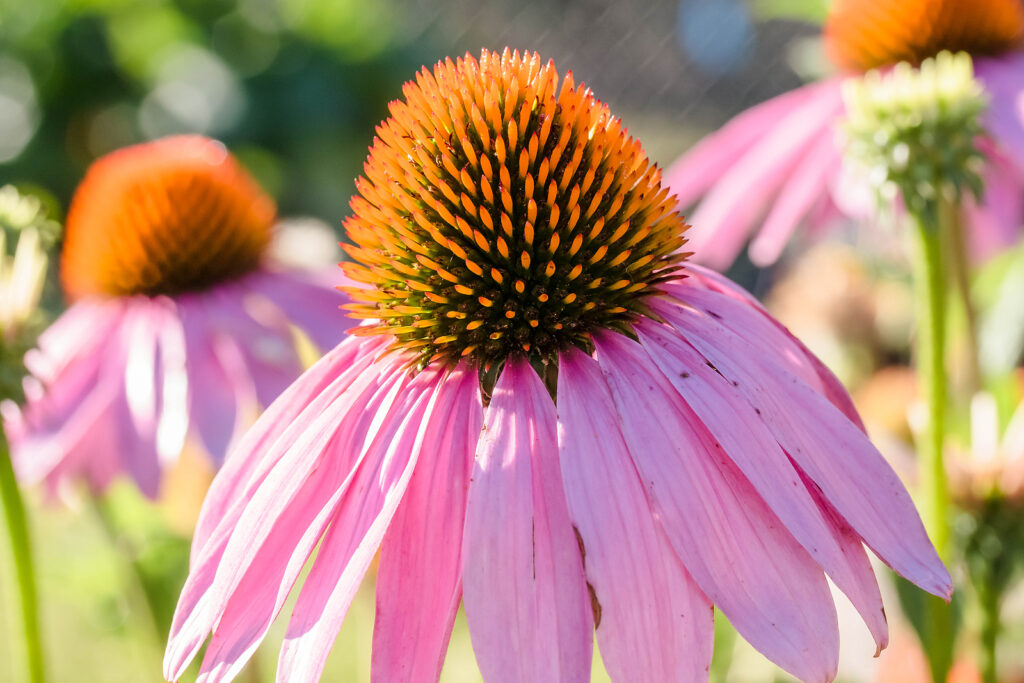Echinacea is a bold upright perennial that bears large daisy-like flowers in purple, rose-pink, or white in late summer. Flowers are up to 6 inches (15cm) across and are composed of radial petals around a cone-shaped center.
Commonly called purple coneflower, Echinacea has gray-green foliage and bristly, oblong leaves. Flowers are borne on tall stems and last for about two months, usually until the first frost. The flowers last well when cut.
Echinacea commonly grows to about 36 inches (91cm) tall but some species and cultivars can grow to 5 feet tall. Plant Echinacea at the rear of a bed or border to create a colorful backdrop.

Get to know Echinacea
- Plant type: Perennial
- Growing Zones and range: Zones 3-9
- Hardiness: Hardy to -35°F (-37°C); cold hardy
- Height and width: 18 to 30 inches (45-76cm) tall; 24 inches (61cm) wide
- Foliage: Stiff stemmed clumps of bristly leaves that range from linear to lance shape to ovate.
- Flowers: Spurred flowers, some double, range of colors and bi-colors; seed heads turn bronze that remains through winter
- Flower colors: Purple, red, pink, white
- Bloom time: Late spring to early summer
- Uses: Flowers attract hummingbirds; grow in woodland, cottage, and meadow gardens and mixed borders; flowers attract butterflies, seeds attract goldfinches
- Common name: Purple Coneflower, Coneflower
- Botanical name: Echinacea purpurea and species
- Family: Asteraceae
- Origin: East Central North America
Where to plant Echinacea
- Plant purple Echinacea in full sun to part shade
- Echinacea can grow in average to poor, well-drained soil.
Echinacea uses and companions
- Use Echinacea in the midground of formal or informal planting.
- Naturalize Echinacea in meadows or butterfly gardens.
- Combine Echinacea with ornamental grasses.
- Good garden companions for Echinacea include Achillea, Aster, Chrysanthemum superbum, Gypsophila paniculata, Rudbeckia, Solidago.

When to plant Echinacea
- Set established Echinacea in the garden in spring or fall.
- Start seed indoors in late winter or early spring for setting plants in the garden in late summer or autumn.
Planting and spacing Echinacea
- Space Echinacea 2 to 3 feet (.6-.9m) apart.
- Sow seed 1/4 inch deep in light potting soil indoors or in an evenly prepared bed outdoors.
How to water and feed Echinacea
- Keep the soil just moist, but Echinacea will tolerate dry soil.
- Echinacea does not require fertilizers.
Echinacea care
- Stake tall Echinacea to avoid flopping.
- Deadhead spent blooms to promote new blooms.
- Leave spent blooms in place to attract birds and butterflies.
- Echinacea readily reseed. Established plants can be divided every 3 to 4 years.
- Caterpillars and Japanese beetles can sometimes be a problem.

Echinacea propagation
- Divide plants from autumn to spring.
- Take root cuttings in early spring; root cuttings in light potting soil.
- Sow seed indoors in late spring; plants can be set in the garden in autumn. Store seeds in the cold (refrigerator) for 4 to 5 weeks before sowing; this will promote better germination.
Echinacea varieties to grow
- Echinacea pallida: Grows to 18 inches (45cm) tall; drooping flowers are pale purple around a purple-brown cone.
- E. purpurea: Grows to 20 inches (51cm) tall; white to purple flowers around an orange-brown center. Cultivars include; ‘White Swan’ is a white cultivar; ‘Crimson Star’ is a red cultivar; ‘Magnus’ is pink with 7-inch flowers; ‘Razzamatass’ is a double-flowered cultivar; ‘Kim’s Knee High’ is a dwarf variety to 2 feet tall.
Echinacea frequently asked questions
Q: What growing conditions does Echinacea like?
A: Echinacea will grow in average well-drained garden soil. It wants full sun. It is native to prairies and open woodlands and adapts well to nearly all gardens. It is hardy to -40°F.
Q: How do I propagate echinacea?
A: The easiest way to propagate echinacea is by division in spring. You can also sow seeds. Sow fresh seeds in the fall or sow seeds in spring 6 to 8 weeks before the last frost. Stored seeds must be stratified. Sow the seeds in pots of moistened medium, cover with plastic wrap, and refrigerate for at least 4 weeks.
Q: When can I collect seeds from echinacea for sowing later?
A: Collect seeds from matured flowers five or six weeks after flowers fade. Seeds are mature when the flower head turns gray. You can grow species from seed, but hybrids and other cultivars may not come true.















